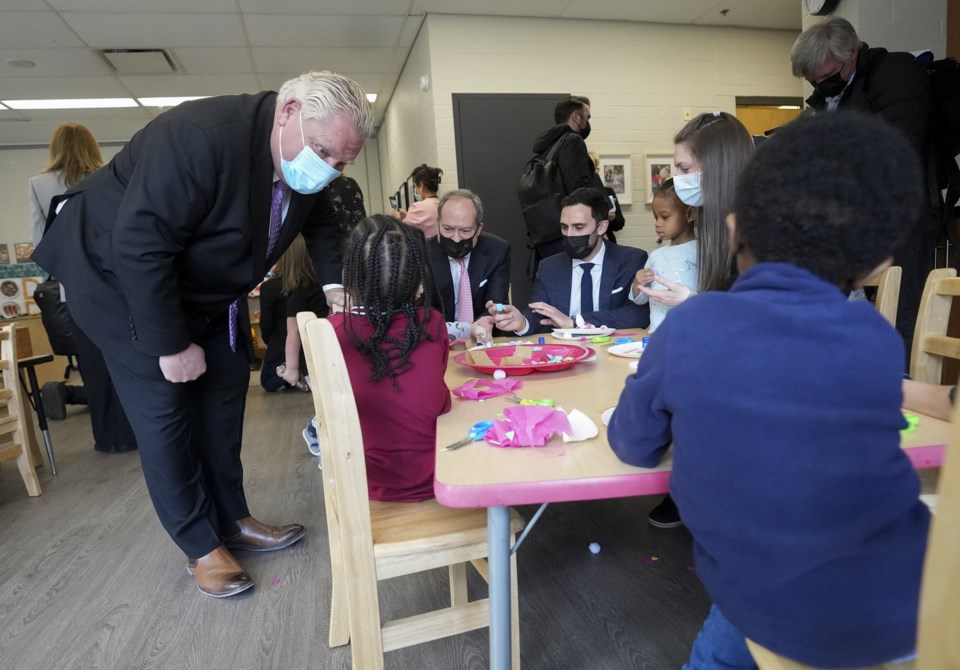TORONTO — Ontario child-care centres that aren't participating in the national $10-a-day program will soon lose provincial funding to offer new fee subsidies to lower-income families and their staff could see a pay cut of $2 an hour.
In a memo sent to licensed operators in Ontario outlining changes to how the province is funding the $10-a-day program, an assistant deputy minister of education wrote that starting in 2025, non-participating centres will no longer receive routine funding such as "general operating, fee subsidy or wage enhancement grants."
Families who already get fee subsidies for child care will continue to benefit until their child ages out or leaves their provider, the memo said, but any new families won't be able to access subsidies for kids aged five and under in centres outside the $10-a-day system.
That money will instead go into funding the $10-a-day program "to ensure the success of that system," according to the memo.
The Ministry of Education last month announced a long-awaited new formula for funding the centres in the $10-a-day program, after many operators said they were struggling to keep their doors open with the province simply replacing the revenue from discounted parent fees.
The new approach is intended to cover operators' actual costs and give them some flexibility, which many said will stabilize the sector for now, though it still may not be ideal for long-term growth.
The accompanying changes that will see funding cut off from non-participating centres will make it harder for them to operate, and therefore harder for families to access care outside the $10-a-day system, said Andrea Hannen, executive director of the Association of Day Care Operators of Ontario.
"When these centres lose access to provincial funding, including the opportunity for their staff to receive provincial wage enhancements and the families they serve to receive provincial fee subsidies, they will have to either close their doors, or dramatically raise their fees," she said.
"This means fewer licensed child care choices for families of modest means."
Any low-income families seeking child care who aren't currently enrolled can apply to their municipality to get a placement in a centre within the $10-a-day program offering subsidies, said a spokesperson for Education Minister Jill Dunlop.
"They may need to wait for a spot, but when it is available, they will be prioritized," Edyta McKay wrote in a statement.
Ontario still offers a tax credit for up to 75 per cent of child-care expenses for lower-income families, she noted.
Operators outside the $10-a-day program have the flexibility to set the fees parents pay based on operational costs, and can offer subsidies and staff pay increases out of their own budgets, McKay said.
Ontario's deal with the federal government to join the $10-a-day program committed the province to create 86,000 new child-care spaces. But, so far, while there have been about 51,000 new spaces, only 25,500 of those are within the $10-a-day system, officials say.
The province says a federal cap on the percentage of for-profit spaces within the system is hampering growth, as municipalities are having to turn down applications for thousands of potential spaces because they are created by for-profit operators.
"We continue to call on the federal government to lift their cap on for-profit providers, which is limiting the opportunity for operators to join the $10-a-day program and access funding, and is limiting the availability of affordable child-care spaces close to home," Dunlop's spokesperson wrote in a statement.
Federal Families Minister Jenna Sudds told Ontario that she was open to a conversation about lifting the cap, but she first needed more information on how the province is trying to spur non-profit space creation, as the $10-a-day system is supposed to be predominantly public and not-for-profit.
Alana Powell, executive director of the Association of Early Childhood Educators of Ontario, said that while a public system is a laudable goal, the loss of the $2-an-hour wage enhancement from the province will be huge for staff in programs outside the $10-a-day system.
"While we support prioritizing movements into the Canada-wide system and the development of the publicly funded system, it is going to be devastating for any educators to experience any wage loss, in particular at a time like right now," she said.
The wage enhancement, which applies to registered early childhood educators and other child-care workers in licensed child care, has been in place since 2016.
After Ontario signed on to the $10-a-day program it set a wage floor for ECEs, and later boosted that minimum pay to $23.86 an hour this year after criticism it was too low to make a dent in a recruitment and retention crisis. Advocates say that level is still too low to attract and keep enough workers to staff the 86,000 promised new spaces.
NDP child care critic Teresa Armstrong said the government's most recent moves don't make sense.
"We should be making it easier for childcare centres to offer affordable childcare and encourage people to work in a sector that offers fair wages for fair work," she wrote in a statement. "Giving a $2-an-hour pay cut for daycare workers? Who does that?"
This report by The Canadian Press was first published Sept. 6, 2024.
Allison Jones, The Canadian Press

